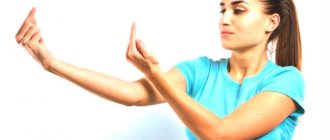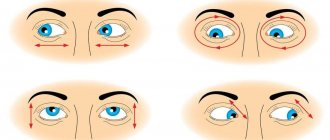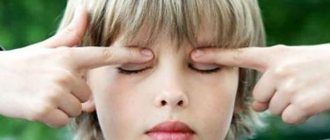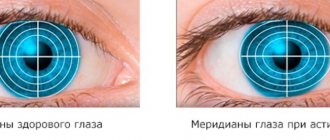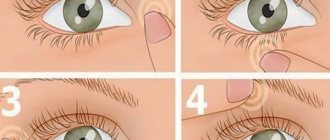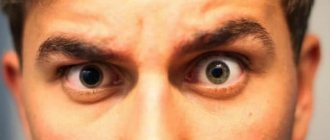General characteristics of the disease
Probably, any parents have noticed that in the first months of life the baby’s eye movements seem to be poorly coordinated: for example, the eyes sometimes turn in different directions, independently of each other.
This is due to the fact that both the muscles themselves (any, not just the eye ones) and the brain control of their activity are not yet sufficiently developed: the central nervous system has yet to learn to live in a complex three-dimensional world, absorbing a huge number of signals coming from outside and reacting adequately to them .
Independent and asymmetrical movements of the eyeballs are considered normal at the stage of rapid formation of tissues, organs and body systems in the period from birth to six months. But not later.
In the first weeks after birth, the visual and motor functions of each eye develop independently; as a result, there is not a single pair of eyes in the adult world that see exactly the same.
At the age of 2-3 weeks, the baby develops the ability to fix his gaze on objects and to follow moving objects with his gaze. The eyes can turn after the object quite synchronously, but in fact these turns are still independent of each other.
By about the fifth week, the visual-analytical center of the brain should try to merge, combine “broadcasts” from each eye into a single image. At the stage of formation of mature binocular vision, mismatched eye movements or positions may still occasionally appear.
From three months, a child, with normal development of the visual system, can confidently focus his gaze on an object, can see and follow it with both eyes at the same time.
A small, unnoticeable strabismus may persist at this stage and is considered transient.
By the fifth month, a complex interaction between the two eyes and the brain should be formed, which allows you to perceive the world as three-dimensional, evaluate the depth of space, the difference in distances, perspective, etc.
But “adult” binocular vision finally develops only by 10-12 years. Therefore, real strabismus, requiring the attention and help of an ophthalmologist, should be identified - and, if possible, corrected - as early as possible.
When is eye gymnastics necessary?
It is difficult for parents to understand whether their child has vision problems and whether measures need to be taken. During standard examinations of a child during the first year of life, a pediatric ophthalmologist can identify any pathological visual impairments, but more often vision deteriorates in older preschool age.
In order not to miss the moment when the child’s vision is just beginning to decline, it is necessary to take into account the following points:
- the child begins to squint when looking at something;
- the child often rubs his eyes;
- his performance in kindergarten and at home decreases;
- he becomes inattentive;
- he develops self-doubt, which may manifest itself in the fact that the child will refuse to do some kind of craft or participate in a game, not because he is lazy, but because he believes in advance that he will not be able to cope with the task and will not achieve good result.
If you take the above symptoms seriously, then by consulting a doctor in time and starting to do gymnastics with your child to improve vision, you can cope with the problem in a short time.
Causes of eye diseases
Vision in children can decrease due to various factors. The main ones are discussed below.
Genetic predisposition
If one of the parents (or both) has any ophthalmological pathology, then the likelihood that the child will sooner or later develop similar problems increases sharply. Therefore, you should not wait until his vision begins to decline. You should visit an ophthalmologist to prevent or detect diseases at an early stage.
Undosed eye strain
In our age of smartphones and gadgets, this is one of the most common causes of vision loss in children. Throughout the day, children's eyes are exposed to television, computers, tablets, smartphones, etc.
It can also be caused by reading too close to the book, in poor lighting, or without a break for a long time. Of course, at the heart of this problem is the negligence of parents who, out of frivolity, allow their child to use gadgets uncontrollably or sit for hours in front of the TV.
Children's eyes need to rest, and it is better that the alternation of stress and rest be within a certain daily routine. Visual fatigue in the initial stages is manifested by headache, dizziness, sleep disturbance, pain and burning in the eyes.
Vitamin deficiency
This problem is also acute among a large number of schoolchildren and younger children. Organizing healthy children's nutrition has a great impact on the quality of vision and overall health.
A child’s daily diet should contain in optimal quantities all the vitamins and microelements necessary for the normal development of the child’s body. If a child systematically does not receive enough vitamins A, B, D, as well as zinc and iron from food, then over time he may develop vision problems.
This problem is now quite relevant and is mainly due to the fact that children from a very early age, with the connivance of their parents, develop an addiction to food that is not at all healthy: a variety of fast food, chips, confectionery delights, sweet carbonated drinks, etc. Naturally, such food cannot contain enough nutrients and vitamins, so important in childhood.
Reading at an early age
There are many fathers and mothers who try by all means to instill in their child a love of books at a very early age, hoping that this child’s inclination will definitely remain with him for the rest of his life. The goal is good, but more often it happens that because of this the child acquires persistent visual dysfunction.
The eyes of young children (up to 4 years old) are designed in such a way that reading for a long time without a break very quickly leads to decreased vision. During this age period, the child absorbs a lot of information, but it must be conveyed to him in different forms.
Diseases
Pathologies of the spine, central nervous, endocrine, immune and other systems. As you know, there is not a single isolated system in the human body. Everything affects everything. Therefore, there are often cases when decreased vision is associated with some organic pathology of other organs.
Insufficient level of physical activity
For the visual system to function normally, it is necessary that cells and tissues are regularly saturated with sufficient oxygen. One of the main ways to maintain tissue oxygen levels at a decent level is to remain physically active.
In recent years, the level of physical activity among children (especially for urban residents) has decreased significantly. This is largely due to the fact that traditional outdoor games could not withstand competition with computers and television.
Neglect of prevention
When a child’s complaints, even if seemingly insignificant at first glance, are left without proper attention from the parents, the disease will progress.
In most such cases, medical help is sought when vision is reduced several times
Therefore, it is important to contact an ophthalmologist when the first symptoms of visual impairment appear in a child.
Little "glasses guy"
According to the Research Institute of Eye Diseases named after. Helmholtz, every third child suffers from visual impairment at school. In primary school, about 8–10% of children suffer from myopia; by the end of school, the figure reaches 25–30%. Myopia (myopia) occurs due to severe eye strain when the child is focused on close objects for a long time: a book, notebook, sketchbook. Because of this, the eyeball lengthens, and the image on the retina becomes unfocused. It turns out that “near” vision progresses at the expense of “far” vision, and the baby begins to complain that he sees distant objects worse.
Often myopic children squint their eyes, claiming that this way they see better. Squeezed eyelids act as a diaphragm, and the image on the retina actually becomes clearer. However, this bad habit compresses the eye, causing the eyeball to elongate even more.
If treatment is not started in time, degenerative changes may occur in the fundus of the eye, which can lead to irreversible loss of vision. Therefore, it is important to regularly show your child to a pediatric ophthalmologist. If myopia is detected, it is important to begin treatment in a timely manner. Modern methods make it possible to stabilize vision in 75–85% of cases, and in the remaining 15% they significantly reduce the rate of myopia progression. If problems have not yet manifested themselves, it is necessary to strictly follow all the rules of prevention.
Preventive visual gymnastics
It is easier to prevent dysfunctions of the eye apparatus than to treat them later. To do this, it is necessary to carry out preventive exercises for vision in all groups of kindergartens and schools. Exercises need to be done constantly, alternating their focus. Methods of preventive gymnastics for vision:
- palming – eyes closed and pressed with palms for 30–40 seconds;
- physical exercise – exercise for eye fatigue;
- ophthalmic simulators – tables and pictures in electronic (presentations) or printed form;
- relaxation – relaxation to relax your vision while listening to music;
- stereo trainer - a ruler with holes, at the end of which a ball is suspended.
In order for children of the junior and middle groups to do gymnastics with pleasure, they need to be motivated to exercise their eyes. The following techniques will help educators and teachers with this:
- poetry;
- music for relaxation;
- games;
- objects of different colors and shapes;
- pictures and posters with diagrams for vision training;
- books or coloring books.
For preschoolers
Visual gymnastics is carried out 3 times a day for 5 minutes. This is enough to improve the functioning of the eye apparatus. If a child in a preschool group already wears corrective glasses with minus or plus diopters, then they need to be removed before classes.
Warm-up for the eyes is carried out using visual material. It serves as a guideline for correctly performed training. For corrective exercise of children in the preparatory group, a card file “Gymnastics for the eyes” is created. This is a set of exercises that are carried out in a playful way using pictures.
Gymnastics for preschoolers consists of a set of exercises. These include:
- "Labyrinth". To complete the exercise, you will need a table depicting multi-colored circles and wavy lines. The child must move his eyes along a given path. The head and neck remain motionless. Exercise time is 30–60 seconds.
- "Here and there." The child follows the bright toy with his eyes. First you need to raise your gaze all the way up, then smoothly move it down. Next, the eyes move to the sides - left and right. It is necessary to do the exercise 4 times - horizontally and vertically.
- "Watch." The child is sitting on a chair. An adult holds a wristwatch with a large dial in front of his face. The child needs to tell the time, while the clock is at a distance of 30–40 cm from the eyes. Then the dial slowly moves away from the child's face by 1 and 1.5 meters. The duration of the exercise is 3 minutes.
For schoolchildren
Children 7–12 years old do visual gymnastics for 7–10 minutes, 2 times a day. It is advisable to do a warm-up every 2 hours after working on the computer or watching TV. Gymnastics to improve vision takes place in a sitting position with a straight back.
The teenager should be explained why the exercise is useful. Visual gymnastics complex for schoolchildren:
- Inhale, move your gaze all the way to the left. Bring your gaze back as you exhale. Perform similar actions on the right side - 5-10 alternations.
- As you inhale, bring your eyes to the tip of your nose and hold your gaze for 10–15 seconds. As you exhale, return to the starting position. Repeat the movement 3-5 times.
- Look down. Simultaneously with inhalation, slowly move your eyes clockwise. At the imaginary number 12, begin to exhale and look in the opposite direction. The number of circles is 7–10.
- Focus your gaze between your eyebrows, then inhale your lungs full of air. After 10–15 seconds, release the air, returning your gaze to the starting position. Repeat the exercise 3-5 times.
- Inhale and look at the upper left corner of the wall. Exhale and return your gaze. Without stopping, do similar actions with the right corner. Number of repetitions – 10–12.
Everything has its time
| Gymnastics for schoolchildren | |
| These simple eye exercises will help your child relieve visual fatigue. >> Shift your gaze from one distant object to another without turning your head. >> Use a felt-tip pen to mark the window glass at eye level with a 3 mm diameter mark. Move 30 cm away from the window and look at the mark for 5 seconds, at the view outside the window for 5 seconds, and so on for 3-5 minutes. >> Lightly massage the eyeballs through the eyelids from the outer corners of the eyes to the inner corners, applying slight pressure - 18 times. >> Rotate your eyes, looking from the book to more distant objects: the ceiling or a picture on the wall. >> Move the lateral surfaces of your thumbs from the wings of the nose to the corners of the eyes, from the beginning of the eyebrows to their end - 18 times. | |
Experts do not recommend sending a child to school before the age of 7: the ciliary muscle, which is responsible for vision, has not yet fully formed at this time (this only happens by the age of 7–8). According to statistics, among children who became first-graders at age 6, there are 3 times more myopia than among schoolchildren who started school at age 7. Visual hygiene is also of great importance. Visual loads should be dosed: if the child sees well, he should take a break every 40 minutes of classes (for 10–15 minutes), if myopia is present - every half hour. During rest periods you need to move and run. This will help relieve eye strain.
The total duration of home lessons should not exceed 1 hour per day for elementary school children and 1.5–2 hours for middle school students. You should also be careful with additional activities: if a child has difficulty coping with the school curriculum, it is better to abandon them. But, if the child can withstand the load and wants to attend clubs or music school, remember that according to sanitary and epidemiological requirements, the duration of one additional lesson on school days should not exceed 1.5 hours, on weekends and holidays - 3 hours. Classes should begin no earlier than 8 am and end no later than 8 pm.
Causes
The main causes and risk factors for the development of strabismus include:
- genetic factors (heredity);
- prematurity, birth weight up to 2 kg;
- pathology of the nervous and muscular systems (multiple sclerosis, myasthenia gravis, etc.);
- congenital abnormalities of the structure of the eyes, especially the eye muscles;
- severe refractive error (myopia, farsightedness, astigmatism);
- oncopathology of the nervous or visual system;
- cataract;
- eye injuries;
- infectious and inflammatory processes in the organs of vision;
- systemic endocrine diseases (for example, rheumatoid arthritis, diabetes mellitus, etc.).
If at least one of the factors listed above is present in the development of a child, the likelihood of developing strabismus increases significantly. Such children are at risk and must be under the supervision of an ophthalmologist.
Rules
It is necessary to carry out eye gymnastics in children taking into account individual characteristics, their state of health and age. In addition, the following rules must be observed:
- Exercises should be carried out regularly, several times throughout the day. In early preschool age, the time of one lesson should be 2-3 minutes, in older preschool and school age - 4-5 minutes.
- Before the main gymnastics, you need to do a short warm-up. The load on the eye system should be increased gradually, increasing the complexity of the exercises. The complex is selected taking into account the age of the children. You should start with simple movements - squinting, blinking, protruding, moving your eyes in a circle, up and down, left and right, gradually complicating the task in all sorts of combinations.
- Training can be carried out at any time - during study, at the beginning, middle, end of the lesson, during a break or a walk.
- Eye gymnastics for very young children is carried out in a playful way, using rhymes, songs, nursery rhymes, etc.
Before starting the workout, you need to take a relaxed position, straighten your neck and back, and keep your head still.
Items selected for training should be presented slowly. The drawing should be bright and large, and located just above the children’s heads, and also correspond to the theme of the lesson. For example, when studying insects, a figurine of a multi-colored butterfly can serve as a reference point.
Children with poor vision should sit or stand next to the teacher, others are located a little further away.
Exercises
In children, a high degree of hypermetropia is usually congenital; this disease is treated surgically. However, since the child’s visual organs are still at the developmental stage, there is a possibility that over time the level of the disease will become minimal or vision will improve. Therefore, eye gymnastics for farsightedness for children has a positive effect, especially at low and medium stages of the disease. Since it is quite difficult for kids to concentrate and perform exercises that help strengthen the eye muscles, it is best to conduct training in a playful way. The eyes are a very important organ, and eye diseases are very serious. Before performing exercises, consult your doctor; there are contraindications (for example, retinal detachment).
For the little ones
Gymnastics exercises for eyes with farsightedness for children under two years of age:
- Using your fingertips, you need to gently massage the child around the eyeball (try not to touch the eyes), while the baby’s eyelids should be closed. The massage session should be carried out for 5 seconds, then the massage should be repeated 5 times, the interval between repetitions is 30 seconds. This training improves blood circulation in the eye and tissues around it.
- The baby lies on his back. Then, with the help of a toy, you need to attract his attention, after which you need to very slowly bring the toy closer to his face, while movements with the toy should be in the form of a “snake”. This exercise should first be repeated no more than 2 times, gradually increasing the number of repetitions up to 5 times. This training activates the work of the ciliary muscle.
From 2 to 5 years
A set of activities for children 2-5 years old:
- You need to attract the child's attention with a bright-colored ball, after which the ball is thrown forward. First, the baby follows the sword with his eyes, then finds it to bring it back.
- The child needs to be seated on the floor, one of the parents needs to sit opposite, the distance between the adult and the child should be 2-3 m, then you need to roll the ball towards the child, then the baby should roll the ball towards you. Lesson time 5 min. This training stimulates visual accommodation.
- Exercise to repeat movements. The baby should see the grimace on your face and repeat it. You can alternately close and open your eyes or squint them. This game improves blood circulation and also helps to activate metabolic processes in the eye organs.
From 5 to 7 years
Lesson for children 5-7 years old:
- You need to let the child read 1-2 lines from a book with large letters, preferably in a bright color, after which the book needs to be brought 15 cm closer to the baby. Now you need to read a couple more lines. This activity should be performed daily for 5 minutes.
- School-aged children can be trained through sports games such as tennis, cricket, basketball, volleyball, badminton or golf. Such sports activities, combined with comprehensive treatment of farsightedness, have a positive effect on vision.
Thus, by training the visual system, you can reduce eye strain, activate blood circulation to the eye organs and improve the elasticity of the eye muscles.
Over 7 years old
Gymnastics for children over 7 years old
Hypermetropia is one of the most common diseases in children. All infants have farsightedness, which usually decreases by the age of 5, and by the age of 13, vision is restored in most cases. However, unfortunately, farsightedness does not go away in all children. For this reason, a farsighted child must undergo comprehensive treatment, which includes vision correction with glasses, hardware procedures and special gymnastics.
Exercises to restore vision in case of farsightedness in children:
- In order to do this exercise, the child needs to turn his face to the window and, while standing, extend his arm so that he can see his palm. Next, you need to look at the palm, then look at the window, now you need to look at what’s outside the window, gradually looking at more distant objects. Then repeat the same steps only in reverse order, that is, the last step is to look at the palm.
- You need to draw numbers with your eyes closed and your palms closed.
- Palming. This type of training involves tightly closing your eyes with your palms for some time. When performing this exercise, it is important that no light falls on your eyes, your palms must be warmed up, for this you need to rub them against each other. In addition, while performing this task you need to relax as much as possible.
It is very important for the eyes to remain in a relaxed position for some time. Relaxation is achieved by looking at distant objects (even if they are hard to see due to vision problems). Good nutrition and good rest are important for vision. Spend more time in nature, play sports (in moderation, because heavy stress is contraindicated for eye diseases), take care of your overall health, and your eyes will work at their maximum capacity.
All these exercises must be carried out after consultation with a doctor. Be healthy!
Eye gymnastics complex for children
In the modern world, it is very difficult to avoid the harmful effects of the environment on the organs of vision, because children from early childhood are accustomed to watch TV or play on a tablet every day. That is why training should begin as early as possible, devoting a few minutes a day to simple exercises.
For kids 2-3 years old
Exercises with babies 2-3 years old should be done emotionally, including playful moments.
The workout starts with simple movements. The complexity of the exercises should increase gradually and not provoke any unpleasant or painful sensations in the baby. After he masters simple tasks, more complex ones are introduced:
- First, it is recommended that an adult independently massage, knead and stroke the eyes of his son or daughter, accompanying his movements with funny rhymes.
- At the age of 2-3 years, the baby is already able to repeat the actions of an adult. The baby is seated next to him and asked to repeat the quick movement of his gaze left and right, up and down, and also pat his eyelids with his fingers. Another simple exercise is to blink frequently and move your gaze in a circle. This warm-up can be done several times a day.
- For a long lesson, you will need to first prepare multi-colored shapes (rectangle, oval, circle, triangle) of different colors and sizes. The figures should be shown one by one. An adult needs to move his finger along the corners of the figure or in a circle, inviting the baby to follow the movement. The training should be accompanied by funny rhymes or songs that the young student will definitely enjoy.
Kids 3-4 years old
Exercises with 3-4 year old children should also begin with a simple warm-up: moving the eyeballs up and down, to the sides, and then introduce more complex exercises:
- The child is asked to close his eyes, count to 5, and then open his eyelids wide.
- Stretch your hand forward, focusing your gaze on the index finger, slowly bring it closer to your face, without taking your eyes off, touch your nose, and then slowly move your hand away.
- Another exciting game is turning into animals: kids must use their imagination and pretend to be a cat, an eagle owl, etc. It is necessary to include the organs of vision in the process: look around, squint, rotate the eyeballs, protrude the eyes.
- For 4-year-old children, you can ask them to mentally draw with their eyes a simple geometric figure, for example, a square or a circle.
- Drawing with the nose. Students try to draw a figure, picture or toy in the air, tracing it with their nose.
For children 5-7 years old
The following exercises are recommended for preschool children:
- "Far close". The baby stands near the window, alternately examining a nearby object, and then turns his gaze to an object located in the distance. The lesson is repeated 7 times.
- The preschooler is asked to mentally imagine the number 8 and draw it with his eyes. If there is difficulty, use a figure drawing. The figure eight can be placed on its side, in the form of an infinity sign. Repeat 7 times.
- "Tic-tac-toe." The gaze is placed in the upper left corner of the room, after which it is transferred to the lower right. Then from the upper right they look at the lower left, after which they move their eyeballs in a circle. This complex is performed several times.
- Movement on the dial. Children stop their gaze at each number on the wall clock for 1-2 seconds. Repeat counterclockwise.
- Closing your eyelids for 15 seconds will help you rest your eyes. Opening your eyes, blink quickly, counting to 5. After a two-second break, repeat several more times.
Gymnastics for myopia according to Zhdanov
Professor V.G. Zhdanov fully shared Bates' beliefs. Many of his exercises have analogies with those developed by the American.
Here are some of them that children can do to prevent myopia:
- You need to “draw” the wings of a butterfly with your eyes. To do this, you should fix your gaze in the lower left corner, then raise your eyes up 15 cm, draw a line to the right, and then again up 15 cm and then from there draw your gaze to the first point from which the drawing began.
- Make rotational movements with your eyes, imagining that you are winding a rope around a pipe.
Eye exercises for schoolchildren
With the beginning of school life, the child becomes more serious, responsible and reasonable. In addition, the baby feels like an adult, so exercising with nursery rhymes becomes irrelevant: more serious and complex tasks are required. I am a Parent has selected three effective exercises that will be of interest to students in junior, and sometimes senior, grades.
Exercise 1. House of palms
The exercise is aimed at improving blood circulation.
In the video lecture “It’s time to take off your glasses” by Vladimir Zhdanov, this exercise is called “palming”. It is recommended as a warm-up before the main exercise for the eyes, as well as to relax the eye muscles. Ophthalmologists recommend performing this exercise every half hour of working at the computer, reading, or watching TV.
Do the exercise yourself, and then show the technique to your child.
Cross your palms so that only your fingers cross. Place the resulting “house” of your palms on the bridge of your nose. Thus, the eyes should be under the grooves in the palms, and the crossed fingers should be on the forehead. Hands should fit tightly to your face, not allowing light to pass through.
Now that your eyes are in complete darkness, begin to “draw” numbers and letters with your eyeballs. For variety, you can make basic movements: blinking frequently, moving left and right, up and down.
This warm-up lasts from one to two minutes.
Exercise 2. Imaginary picture
An exercise to improve “accommodation” - the ability to clearly see objects at different distances from the eye.
This exercise is recommended for school-age children, as well as adults. It not only improves vision, trains all the muscles of the eye, but also promotes the development of fantasy and imagination, which is especially important when it comes to elementary school students.
Together with your child, draw a picture on a piece of whatman paper: a sandy shore, the sea, rocks are visible in the distance, a boat is rocking on the waves
Pay attention to small details: birds in the sky, pebbles on the shore, waves
When the blank is ready, attach it to the wall and invite the child to peer at the painted picture, look at the little details drawn, and also come up with something of his own. Later, when the child learns to imagine the seashore without auxiliary materials, the picture can be removed.
The exercise time should not exceed five to seven minutes. If the child gets bored early, the lesson should be stopped.
Exercise 3. Drawing a nose
An exercise to relieve tension from the eyes and neck.
The eyes are not the only vulnerable spot for schoolchildren. Sitting at a desk for a long time contributes to the deterioration of blood flow in the neck, which causes tension and even pain, which also affects vision. A simple exercise will help prevent these unpleasant consequences.
Invite your child to draw an object or letter in the air with his nose. Try to guess what was drawn. Children really like such tasks, so gymnastics will turn out not only useful, but also enjoyable.
Visual gymnastics is simple but useful. Children who are taught to do it from an early age do not experience vision problems later, when the load on the eyes increases significantly. The special advantage of the exercises is that they do not require much time: just nine minutes a day - three times for three minutes - and the child will be protected from the prospect of wearing glasses at a young age.
Maria Pomozova
Child's immunity status
Immunity is the body’s ability to resist various diseases. How strong is your child's immunity? Does your baby get sick often? Or do all epidemics pass unnoticed for him? Take the test and get expert recommendations. Take the test
Right on time
Often, eye fatigue occurs due to a banal lack of sleep. Lack of night sleep among schoolchildren is a common problem. You can compensate for it by resting during the day after school. But it is better for the child to go to bed no later than 22.00 and sleep for 9.5–10 hours. Try to stick to a clear routine, alternating between different types of activities: wakefulness and rest, sports events and walks, classes and games. A healthy schedule will contribute to good health, strengthening the nervous and visual systems.
Watching TV shows or playing on the computer should not be considered relaxation. All this significantly increases the strain on the eyes - the advent of information technology has doubled the incidence of myopia.
Children's vision
Table of contents
Children spend most of their personal time playing games on a tablet, phone, computer, and at the same time, their eyes are directed for a long time at an object located in close proximity. The need to look around and into the distance practically disappears and structural changes begin. To reduce the load, parents should limit playing time and watching TV shows that require fixation of vision at one point at the same distance. And be sure to do gymnastics after this to relieve tension from the organ of vision.
As a preventative measure for eye diseases and their treatment in complex therapy, ophthalmologists recommend using eye exercises for schoolchildren, which will help relax muscles after prolonged exercise, improve blood circulation and help strengthen muscle fibers. There are practically no contraindications for preventive exercises and this can be done starting in kindergarten, gradually making them a habit. Gymnastics can be done in a playful way using rhymes or jokes.
Currently, ophthalmologists have recorded a significant increase in eye diseases in children of primary and secondary school age, which were previously observed only in older people. This is primarily due to an increase in the load on fragile eye muscles. The main problems include the development of astigmatism, strabismus, myopia, myopia and other diseases.


